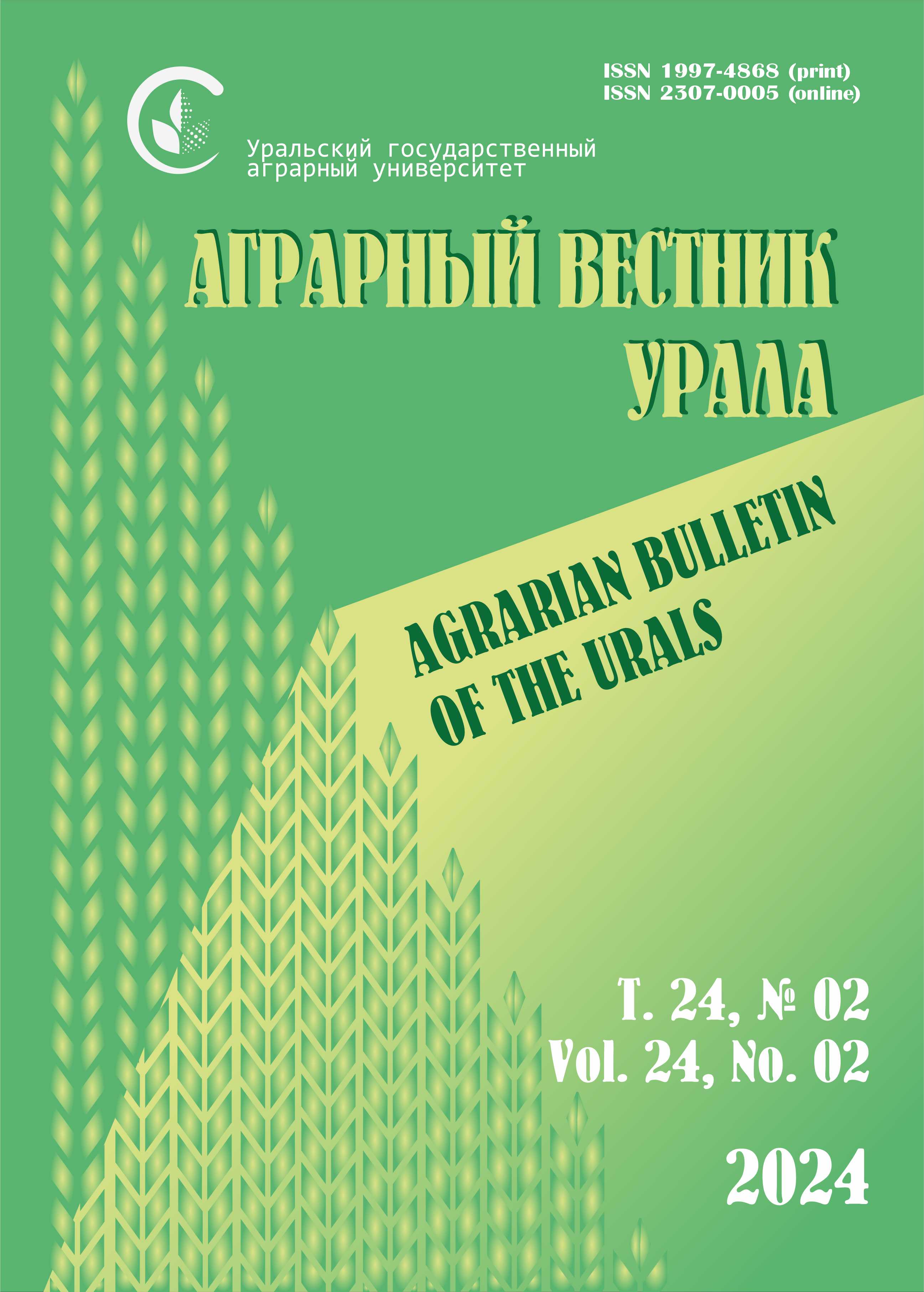Bryansk, Russian Federation
Abstract. The purpose of this study is to evaluate different ways of lupine cultivation in a crop rotation as a factor for its biologization and soil fertility’s conservation. Scientific novelty. The effect of different techniques of lupine cultivation in a crop rotation on the productivity and soil fertility has been studied in the All-Russian Lupine Scientific Research Institute on the gray forest sandy-loam soil like loam of the Non-Chernozem zone of Bryansk region. Methods. The tests have been done during two contrast periods. The first period, 1999–2003, is the third rotation of two five-field crop rotations “oat – lupine – fodder beet – barley – winter wheat” and “green-manure fallow – winter wheat – lupine – fodder beet – barley”. The second one, 2010 – 2015, is the second rotation of two six-field crop rotations “spring rape – lupine – barley – winter rape – lupine – spring wheat” and “green manure fallow – winter triticale – lupine – spring wheat – spring rape – barley”. Results. It was revealed that the inclusion of lupine green manure field together with lupine field for grain provided the stability and the average crop productivity increase in time as in the complete absence of chemical load from 43.6 t/ha to 44.4 t/ha in 1999–2003, and from 12.9 t/ha to 13.9 t/ha in 2010–2015. Lupine use for the green-manured fallow in a crop rotation contributes to the stability of soil fertility. The humus content increased by 0.08 % both in 1999–2003 and in 2010–2015 by 0.08 %; it occurs at alternative crop cultivation technology which is completely chemicals free when there is a possibility to observe direct action of the crop rotation itself. It is confirmed by a positive balance from 0.06 t/ha at the minimal level of chemicals’ use to 0.15 t/ha at intensive chemicals’ use per a hectare of the crop rotation area.
crop rotation, fertilizer, green manuring, lupine, fertility, yield
1. Esedulaev S. T., Mel'caev I. G. Biologizirovannye sevooboroty - osnovnoy faktor povysheniya plodorodiya dernovo-podzolistyh pochv i produktivnosti pashni v Verhnevolzh'e // Agrarnyy vestnik Urala. 2019. № 11 (109). S. 18-26. DOI:https://doi.org/10.32417/article_5dcd861e3d2300.42959538. EDN: https://elibrary.ru/BQQLHO
2. Prosyannikov E. V. Agrohimicheskie aspekty ustoychivogo zemledeliya // Sel'skohozyaystvennaya biologiya. 2019. № 5. S. 13-16. DOI:https://doi.org/10.24411/0235-2516-2019-10068. EDN: https://elibrary.ru/CDQBWB
3. Zavalin A. A., Sokolov O. A., Shmyreva N. Ya. Azot v agrosisteme na chernozemnyh pochvah. Moskva: RAN, 2018. 180 s. EDN: https://elibrary.ru/UVIAVY
4. Isaeva E. I., Afonina E. V., Lyapchenkov V. A. Korma na osnove lyupina // Mnogofunkcional'noe adaptivnoe kormoproizvodstvo: sbornik nauchnyh trudov. Moskva, 2018. Vyp. 17 (65). S. 15-22. EDN: https://elibrary.ru/UUVMFI
5. Yakovlev A. S., Makarov O. A., Evdokimova M. V., Ogorodnikov S. S. Degradaciya zemel' i problemy ustoychivogo razvitiya // Pochvovedenie. 2018. № 9. S. 1167-1174. DOI:https://doi.org/10.1134/S0032180X18090149. EDN: https://elibrary.ru/UWYIAN
6. Kudeyarov V. N. Pochvenno-biogeohimicheskie aspekty sostoyaniya zemledeliya Rossiyskoy Federacii // Pochvovedenie. 2019. № 1. S. 109-121. DOI:https://doi.org/10.1134/S0032180X1901009X. EDN: https://elibrary.ru/YVZMOL
7. Sychev V. G., Shevcov L. K., Belichenko M. V., Ruhovich O. V., Ivanova O. I. Vliyanie dlitel'nogo primeneniya razlichnyh sistem udobreniya na organoprofil' osnovnyh zonal'nyh tipov pochv // Plodorodie. 2019. № 2 (107). S. 3-6. DOI:https://doi.org/10.25680/S19948603.2019.107.01. EDN: https://elibrary.ru/ZDDZSH
8. Chebotarev N. T., Yudin A. A., Konkin P. I. Vliyanie dlitel'nogo primeneniya udobreniy v kormovom sevooborote na plodorodie i produktivnost' dernovo-podzolistoy pochvy v usloviyah Evropeyskogo Severo-Vostoka // Agrarnyy vestnik Urala. 2018. № 10 (177). S. 23-28. DOI:https://doi.org/10.32417/article_5claSfaa30e523/76893969.
9. Lukin S. M., Zolkina E. I., Marchun E. V. Vliyanie dlitel'nogo primeneniya udobreniy na produktivnost' sevooborota, soderzhanie i kachestvennyy sostav organicheskogo veschestva pochvy // Plodorodie. 2021. № 3. S. 93-98. DOI:https://doi.org/10.25680/S19948603.2021.120.18. EDN: https://elibrary.ru/KRNLMV
10. Zaharova M. A., Yumashev H. S., Izmenenie gumusnogo sostoyaniya chernozemnyh pochv Chelyabinskoy oblasti v rezul'tate sel'skohozyaystvennogo ispol'zovaniya // Vestnik KrasGAU. 2022. № 2. S. 3-11. DOI:https://doi.org/10.36718/1819-4036-2022-2-3-11. EDN: https://elibrary.ru/GKGCBR
11. Rusakova I. V. Mikrobiologicheskie i ekofiziologicheskie parametry dernovo-podzolistoy pochvy pri dlitel'nom primenenii solomy i mineral'nyh udobreniy i ih svyaz' s urozhaynost'yu // Sel'skohozyaystvennaya biologiya. 2020. T. 55. № 1. S. 153-162. DOI:https://doi.org/10.15389/agrobiology.2020.1.153rus. EDN: https://elibrary.ru/NNATUV
12. Yagovenko G. L., Lukashevich M. I., Ageeva P. A., Novik N. V., Misnikova N. V. Evaluation of the modern lupine varieties developed in the All-Russian Lupin Scientific Research Institute // IOP Conference. Series: Earth and Environmental Science. 2022. Article number 012096. DOI:https://doi.org/10.1088/1755-1315/1010/1/012096. EDN: https://elibrary.ru/EABTSG
13. Sychev V. G., Shafran S. A. Prognoz plodorodiya pochv Nechernozemnoy zony v zavisimosti ot urovnya primeneniya udobreniy // Plodorodie. 2019. № 2 (107). S. 22-25. DOI:https://doi.org/10.25680/S19948603.2019.107.07. EDN: https://elibrary.ru/VCUCGS
14. Artyuhov A. I., Selivanova M. A., Isaeva E. I. Adaptaciya vidov lyupina v agrolandshafty Rossii // Novye metody i rezul'taty issledovaniy landshaftov v Evrope, Central'noy Azii i Sibiri: monografiya v 5 tomah. T. 4. Optimizaciya sel'skohozyaystvennyh landshaftov. Moskva, 2018. S. 78-83. DOI:https://doi.org/10.25680/6578.2018.64.40.280. EDN: https://elibrary.ru/YTTQHZ
15. Yagovenko G. L., Lukashevitch M. I., Ageeva P. A., Novik N.V., Zakharova M. V. Status and prospects of breeding of cultivated species of Lupin in Russia // IOP Conference Series: Earth and Environmental Science. 2021. Article number 012014. DOI:https://doi.org/10.1088/1755-1315/663/1/012014. EDN: https://elibrary.ru/QCOLDM
16. Dedov F. V., Nesmeyanova M. A. Vliyanie propashnyh kul'tur i parov na pokazateli plodorodiya pochvy i produktivnost' sevooborotov // Izvestiya Orenburgskogo gosudarstvennogo agrarnogo universiteta. 2018. № 4. S. 33-36. EDN: https://elibrary.ru/XYKUDZ









